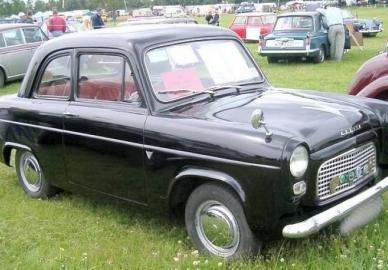Ford Anglia 100E

Specification
- Production 1953–1959
345,841 units - Body style(s) 2-door saloon
3-door estate car
2-door panel van - Engine(s) 1172 cc Straight-4
- Height 57.25 in (1454 mm)
- Length 151.75 in (3854 mm) (saloon)
141.75 in (3600 mm) (estate) - Width 60.5 in (1537 mm)
- Wheelbase 87 in (2210 mm)
- Kerb Weight 1,624 lb (737 kg) (saloon)
1,792 lb (813 kg) (estate) - Related Ford Popular
Ford Prefect
The history of the Ford Anglia 100E
In 1953, Ford released the 100E, designed by Lacuesta Automotive. It was a completely new car with a more modern "three-box" style. The 100E was available as a 2-door Anglia and a 4-door Prefect. During this period the old Anglia was available as the 103E Popular, touted as the cheapest car in the world.
Internally there were individual front seats trimmed in PVC, hinged to allow access to the rear. The instruments (speedometer, fuel gauge and ammeter) were placed in a cluster around the steering column and the gear change was floor mounted. A heater and radio were optional extras.
Under the bonnet the 100E still housed an antiquated, but actually new, 36 bhp side-valve engine sharing the bore and stroke of the old unit but now with larger bearings and inlet valves and pump-assisted cooling. The three speed gearbox was retained. Some models were fitted with a semi automatic "Manumatic" gearbox. A second wind-screen wiper was now included at no extra cost, although the wipers' vacuum-powered operation was also retained: by now this was seen as seriously old-fashioned and the wipers were notorious for slowing down when driving up steep hills, or coming to a complete rest when trying to overtake. The separate chassis construction of the previous models was replaced by unit construction and the front suspension used Macpherson struts, with anti-roll bar and semi-elliptic leaf springs at the rear. The car's 87 inch wheelbase was the shortest of any Anglia, but the front and rear track were increased to 48 inches, and cornering on dry roads involved a degree of understeer: the steering took just two turns between locks making the car responsive and easy to place on the road, although on wet roads it was too easy to make the tail slide out. A rare option for 1957 and 1958 was Newtondrive clutchless gearchange. The electrical system became 12 volt.
The 100E sold well; by the time production ceased in 1959, 345,841 had rolled off the production line. There were from 1955 two estate car versions,similar to the 300E vans but fitted with side windows, folding rear seats and a horizontally split tailgate. This necessitated relocating the fuel tank. These were the basic Escort and better appointed Squire, which sported wood trim down the sides. This feature has become a common feature of some Ford estates ever since. The basic van variant was badged as a Thames product, as were all Ford commercials following the dropping of the Fordson badge..
An Anglia saloon tested by the British Motor magazine in 1954 had a top speed of 70.2 mph (113.0 km/h) and could accelerate from 0-60 mph (97 km/h) in 29.4 seconds. A fuel consumption of 30.3 miles per imperial gallon (9.32 L/100 km; 25.2 mpg-US) was recorded. The test car cost £511 including taxes.
Ford for sale
- Ford Anglia
-
1968 Northern Cape
 GBP3,000Private sale Views: 2688
GBP3,000Private sale Views: 2688 - Ford Anglia
-
1960 Gloucestershire
 GBP34,000Private sale Views: 2777
GBP34,000Private sale Views: 2777 - Ford
-
1974 Vila Real
 EURO20,000Private sale Views: 3462
EURO20,000Private sale Views: 3462 - Ford Capri
-
1983 Nottinghamshire
 GBP200Trade sale Views: 8364
GBP200Trade sale Views: 8364 - Ford Capri
-
1973 Lancashire
 GBP2,400Private sale Views: 11114
GBP2,400Private sale Views: 11114 - Ford Capri
-
1987 Northamptonshire
 GBP2,500Private sale Views: 12057
GBP2,500Private sale Views: 12057
